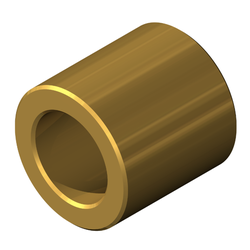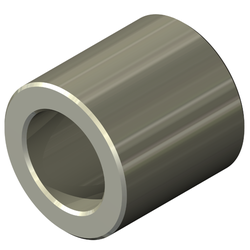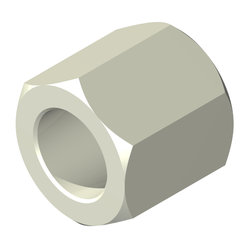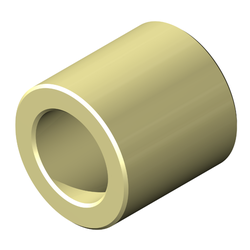Selection Guide:
Steps to Selecting the Right Spacer
Step 1 - Spacer Type
Based on the installation method, choose between the standard spacer or the swage spacer.

Spacers
The most common spacer type and used in most situations. These can be installed with just a screw and nut. Quick and easy to install, versatile in it’s uses, and able to be removed in the future.

Swage Spacers
Great for high volume and automated production. The swage spacer has a swage end that can be inserted into a through hole in the board and be swaged into place (like riveting). The part will not move around while waiting for final assembly. Swage spacers come in common sizes to fit standard circuit board thicknesses and drill hole sizes. Installed using a punch and anvil to swage the part into place.
Step 2 - Inner Diameter (ID)
The inner diameters offered are designed so standard male screw threads can fit through without interference. This type of fit is called a clearance fit and why the ID can also be referred to as a “clearance hole”. You can filter through available spacers based on the “screw size” (eg. #4, #10, M3, M6) and review all the spacers that fit your screw. Review the standard options available below.
| Screw Size | Spacer ID Code | Clearance Hole Range (Inch) |
|---|---|---|
| #0 | 00 | 0.062"-0.072" |
| #2 | 02 | 0.088"-0.098" |
| #4 | 04 | 0.114"-0.124" |
| #6 | 06 | 0.140"-0.150" |
| #8 | 08 | 0.166"-0.176" |
| #10 | 10 | 0.192"-0.202" |
| #12 | 12 | 0.218"-0.228" |
| 1/4" | 25 | 0.252"-0.262" |
| 5/16" | 31 | 0.315"-0.325" |
| 3/8" | 38 | 0.377"-0.387" |
| Screw Size | Spacer ID Code | Clearance Hole Range (Metric) |
|---|---|---|
| M1.6 | 16 | 1.67mm-1.93mm |
| M2 | 20 | 2.07mm-2.33mm |
| M2.5 | 25 | 2.57mm-2.83mm |
| M3 | 30 | 3.07mm-3.33mm |
| M3.5 | 35 | 3.57mm-3.83mm |
| M4 | 40 | 4.07mm-4.33mm |
| M5 | 50 | 5.17mm-5.43mm |
| M6 | 60 | 6.17mm-6.43mm |
| M8 | 80 | 8.37mm-8.63mm |
Step 3 - Outer Diameter (OD)
For any ID, you may also consider going with a larger or smaller outside diameter (OD) to create a thick spacer or a thin spacer.
A Large OD creates a thicker spacer and is an easy way to add strength. The larger OD spacers will resist bending or warping during installation compared to a smaller OD. In addition, the large OD provides added surface area where the board and spacer meet. This will reduce any potential for indentation or other damage on soft or delicate materials.
Smaller OD’s form a thin spacer and are perfect when space and weight are the primary concern. Choosing a smaller OD will decrease the footprint of the spacer and allow added room for other components, while reducing the overall weight of the part.
| Outside Diameter | Tolerance | |
|---|---|---|
| Inch | 1/8" (0.125") - 1-1/4" (1.250") | ±.005 |
| Metric | 4.5mm - 32mm | ±.13 |
Step 4 - Length
Spacer Lengths are made true to size and held to a precise tolerance of +/-0.005 inch or +/- 0.13mm. To avoid needing multiple parts to fill up the distance between boards, many different lengths are readily available. Measure the distance between boards and find the length that matches up.
| Overall Length Range | Tolerance | |
|---|---|---|
| Inch | 1/8" (0.125") - 2" | ±.005 |
| Metric | 3mm - 51mm | ±.13 |
Step 5 - Profile
Profile – Round spacers are the most common, but hex and square shapes are also available. The hex and square profiles offer flat sides for a variety of purposes, but can also serve as an easily-recognizable, visual cue to differentiate similar components during high-volume installation.
Step 6 - Material & Plating Options
When deciding on a material and plating/finish, there are many properties that can be considered. The most common ones include corrosion and rust resistance, magnetism, electrical conductivity, strength to weight properties, color, and cost. Review the chart below to see which standard material has the right properties for your application’s environment.
For an explanation of RoHS, Conflict Minerals, WEEE and REACH
visit our Technical Section.
| Materials | Corrosion Resistance | Magnetic | Electrical Conductor | Strength to Weight | Color | Plates |
|---|---|---|---|---|---|---|
| Stainless Steel | High | Slightly | Yes - Poor | Above Average | Grey | Available |
| Steel | Low | Strongly | Yes - Poor | Average | Grey | Available |
| Aluminum | Average | No | Yes - Average | Very Above Average | Grey | Available |
| Brass | High | No | Yes - Below Average | Average | Yellow | Available |
| Nylon | High | No | No | Average | White and can be dyed to other colors | No |
Have a Question About Spacers?
Electronic components are unique and guides can’t always answer everything. Please fill out this form and we will get right back to you.












